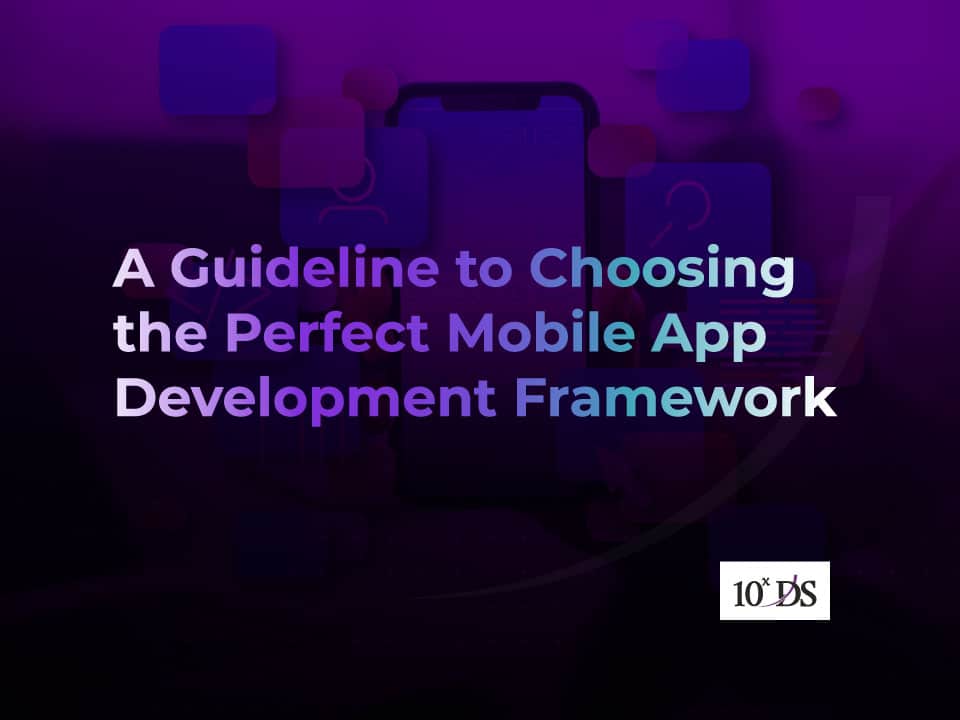
A Guideline to Choosing the Perfect Mobile App Development Framework
Mobile apps are now essential in our lives, changing how we engage, work, and navigate digitally. These small programs for smartphones and tablets have the potential to transform our routines. People expect apps to be user-friendly, reliable, fast, secure, and updated, catering to various needs. In the dynamic tapestry of today’s fast-paced digital epoch, mobile apps stand as imperative instruments for businesses to engage users, optimize operational efficiency, and extend their influence on broader horizons. As the demand has grown, various development frameworks have emerged, providing creators with a range of tools and resources. At the heart of this transformation lies the mobile app development framework- a medium bridging the gap between software construction, debugging, and programming interfaces. This selection holds a profound impact on an app’s trajectory towards success.
The landscape of mobile apps reveals itself in three primary archetypes:
- Native App, which means software applications developed and designed for a specific platform or mobile device and it exhibits superior speed compared to web apps and can function offline.
- Web Apps, which operate exclusively with an internet connection and require a web browser for execution. These Apps are functional across browsers like Chrome, Firefox, and Internet Explorer, web apps provide valuable flexibility.
- Hybrid Apps represent a fusion of native and web apps, embodying the strengths of both approaches. By encompassing features from both native and web apps, hybrid apps provide a comprehensive user experience that leverages the advantages of each approach.
Let’s get familiarised with a few frameworks and their basic features.
The mobile app developers choose different frameworks based on the requirements. For instance, Flutter is an ideal choice for projects that demand a single codebase for both iOS and Android, with customizable widgets, fast performance, and rich UI animations. React Native is commonly selected when the reusability of components, support for native modules, and strong community backing are crucial. Ionic, on the other hand, suits cross-platform development needs, offering pre-designed UI components and integration with native device features using Cordova plugins. Xamarin stands out for those seeking a shared codebase for iOS, Android, and Windows apps, complete with native performance and access to native APIs. Native Script is preferred for its cross-platform support, ability to customize UI components and integration with Angular and Vue.js frameworks. PhoneGap (Apache Cordova) offers an option for those who prioritize write-once-deploy-everywhere, enabling easy access to native device features through plugins. For native iOS development, Swift UI provides a declarative syntax and seamless integration with other Swift libraries and Kotlin Multiplatform suits projects requiring shared business logic across iOS and Android platforms, with seamless integration into existing Android projects.
Here in this blog, an effort is made to put forth those points that might help in making the most informed decision for your app development journey. With the above-mentioned frameworks as the backdrop, the path to selecting the ‘Right Mobile App Development Framework’ becomes clearer:
The basics to know before choosing the ‘Right Mobile App Development Framework’.
Embarking on the journey to choose the ideal mobile app development framework involves considering critical factors. There are many factors such as team expertise, targeted platforms, performance needs, and desired features for the app. Let’s go one by one.
Know Your App’s Goals
Before finalising your choice of framework, it is crucial to define your app’s objective, target audience, and essential features. Is your app focused on iOS, Android, or both platforms? Does it require complex functionality or have specific design requirements? Clearly outlining your app’s purpose and functionality will help narrow down the list of suitable frameworks.
Choose the Right Platform
As we have mentioned before, different mobile app development frameworks cater to various platforms. Decide whether your app should work on just one type of device or many, guiding the choice between iPhone, Android, or both.
Speed Up Development
Time to market is often crucial for businesses looking to stay competitive. Consider the development speed and efficiency of the framework you choose. As mentioned earlier, cross-platform frameworks like Flutter and React Native offer the advantage of faster development cycles due to shared codebases and pre-built components. However, native frameworks might provide more fine-tuned control over specific features.
Assess Community Support and Documentation
The strength of a framework’s community can greatly impact your development process. A robust community means more resources, libraries, and plugins available for your app’s development. Additionally, thorough documentation can significantly expedite the learning curve for your development team. Research the framework’s community involvement and the quality of its documentation before making your decision.
Plan for the Long Run
Choosing a mobile app development framework is not just about the initial development phase; it’s also about the long-term maintenance of your app. Consider factors like the framework’s update frequency, support for emerging technologies, and adaptability to changing user expectations. A framework that offers ongoing support and keeps up with industry trends can save you from future headaches.
Enhancing User Experience and Performance
Prioritize frameworks that enable the creation of visually appealing and intuitive user interfaces, while also choosing a framework that ensures smooth and efficient app performance. Native frameworks are known for providing seamless user experiences and optimized performance, as they directly interact with the device’s hardware and operating system. However, cross-platform frameworks have improved significantly in this area.
Keep It Secure
Security emerges as a paramount concern, prompting us to seek frameworks that come fortified with built-in security features. This ensures that user information remains safeguarded, contributing to the overall trustworthiness of the app.
Learn and stay ahead
Choose a framework that matches your team’s skill level, reducing the learning curve and ensuring a selection that stays updated and aligned with the latest technology trends.
In our pursuit of these essential considerations, we also emphasize the importance of efficient issue resolution that involves selecting a framework equipped with robust testing tools, enabling us to effectively identify and rectify coding mistakes. Moreover, we make certain to provide uninterrupted user experiences through frameworks that offer offline functionality as needed. As we navigate this decision-making process, we conscientiously assess framework costs to strike a harmonious balance between functionality and fiscal responsibility, ensuring alignment with our available budget.
The selection of the ‘Right Mobile App Development Framework’ is an intricate pursuit laden with implications for app success. With various factors at play, these key points serve as guides, helping you make informed decisions. As mobile apps reshape our digital world, this process showcases our progress-blending innovation and user-focused design in an ever-changing tech landscape. For further insights into mobile app development and its advancements, please reach out to us at 10xDS.


